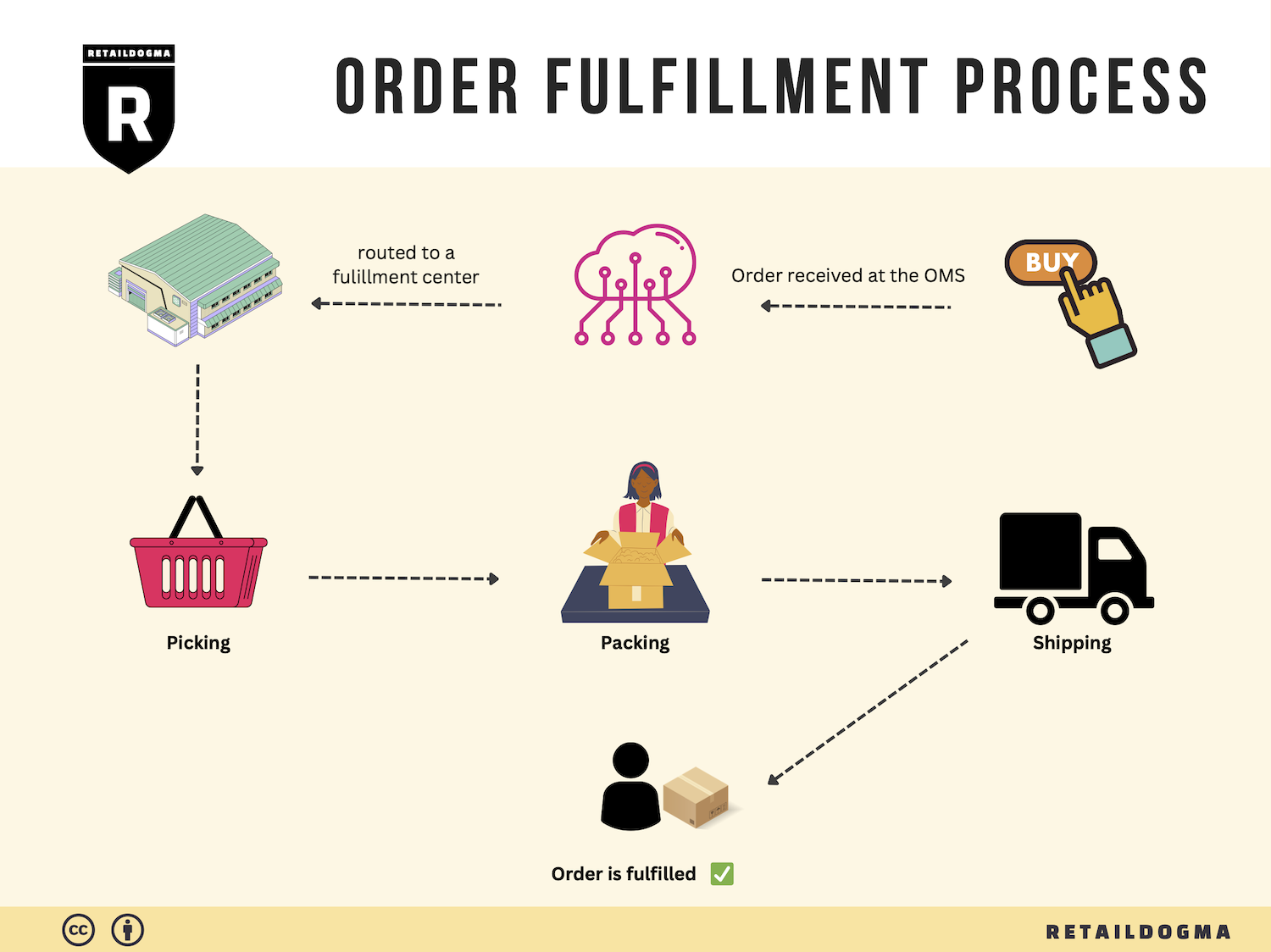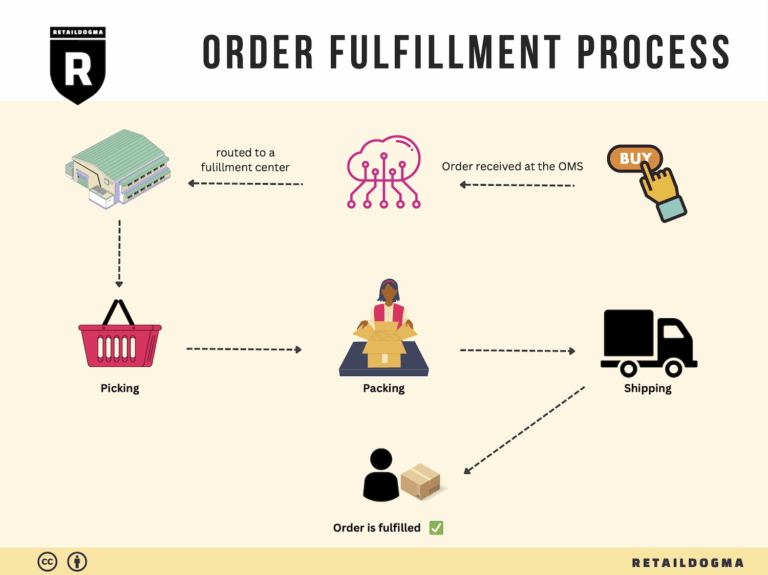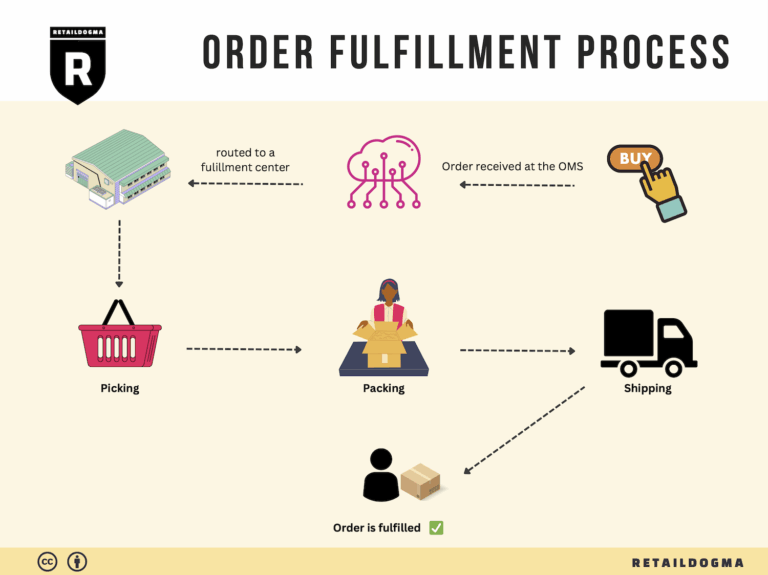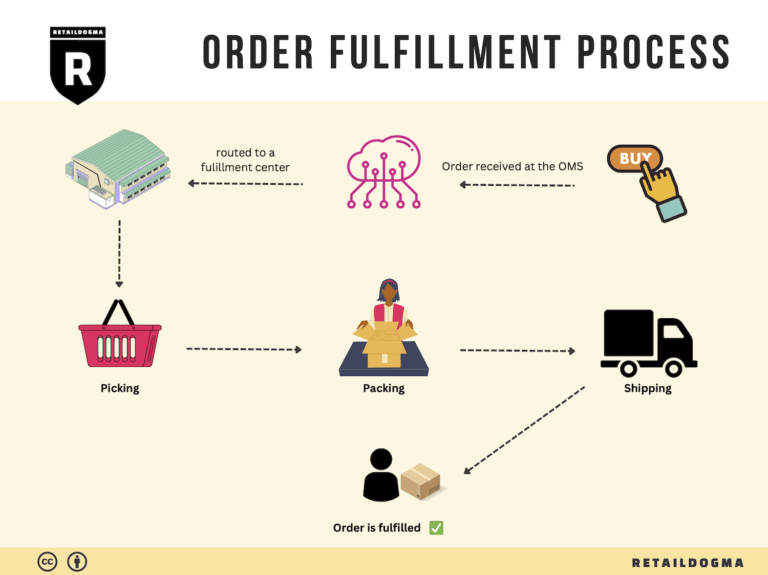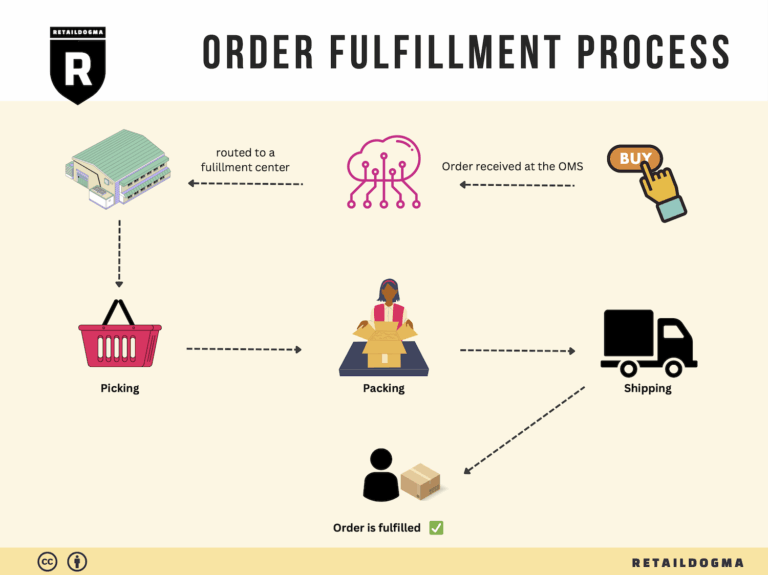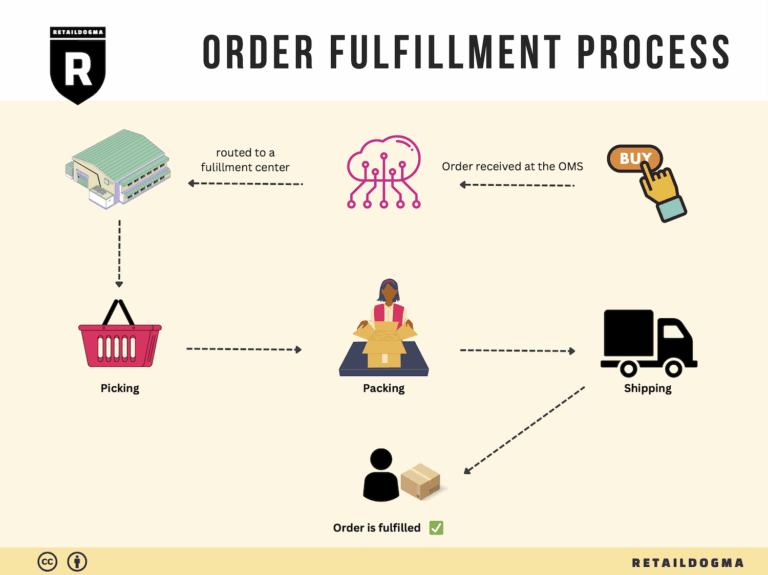Ecommerce Fulfillment Services: The Ultimate Guide (2025)
What is E-commerce Fulfillment? An Introduction for Growing Businesses
As an e-commerce business owner, you may have found yourself overwhelmed by the intricacies of packing and shipping orders. The excitement of launching your online store can quickly turn into stress as you face the logistical challenges of fulfilling customer orders efficiently. This is a common pain point for growing businesses, where the need for swift and accurate order fulfillment becomes paramount to maintaining customer satisfaction and driving repeat sales.
E-commerce fulfillment refers to the entire process of getting a product to a customer, from the moment an order is placed until it arrives at their doorstep. This involves various critical steps, including inventory management, picking, packing, shipping, and handling returns. As your business scales, mastering these processes becomes increasingly complex and time-consuming, often diverting your focus from core activities such as product development and marketing.
In this guide, we will explore the different fulfillment models available to e-commerce businesses, including Third-Party Logistics (3PL) and Fulfillment by Amazon (FBA). Each model comes with its own set of advantages and challenges, and understanding these can help you determine the best fit for your operational needs.
We will delve into the core services offered by fulfillment partners, which encompass everything from warehousing and inventory management to shipping and returns processing. You will learn how to evaluate potential partners based on their capabilities, technology, and customer service, ensuring you choose a logistics provider that aligns with your business goals.
Pricing is another critical factor we will address, as fulfillment costs can vary significantly based on volume, service level, and specific requirements. Understanding these costs will empower you to make informed decisions that positively impact your bottom line.

The ultimate goal of this guide is to equip you with the knowledge and insights needed to make smart decisions about your logistics strategy. By selecting the right fulfillment partner and optimizing your processes, you can enhance operational efficiency, improve customer satisfaction, and scale your e-commerce business successfully.
What You’ll Learn In This Guide
- What is E-commerce Fulfillment? An Introduction for Growing Businesses
- The Order Fulfillment Process: From ‘Buy’ Button to Customer’s Door
- Comparing Fulfillment Models: In-House vs. 3PL vs. Dropshipping
- A Deep Dive into Amazon FBA: Pros, Cons, and Who It’s For
- Core Services Offered by Fulfillment Centers
- How to Choose a Fulfillment Partner: A 6-Point Checklist
- Understanding Fulfillment Pricing: A Breakdown of Common Fees
- Frequently Asked Questions (FAQs) about Fulfillment
- Conclusion: Is Outsourcing Fulfillment the Right Move for Your Business?
- Important Disclaimer
The Order Fulfillment Process: From ‘Buy’ Button to Customer’s Door
1. Receiving Inventory
The order fulfillment process begins with receiving inventory at the fulfillment center. This step involves checking shipments against purchase orders to ensure accuracy in quantity and quality. Products are inspected for any damage, and discrepancies are noted for resolution.
Importance: Proper receiving of inventory is crucial because it sets the foundation for all subsequent steps in the fulfillment process. An efficient receiving process ensures that the right products are available for order fulfillment, reducing the risk of stockouts or delays.
Key Term: SKU (Stock Keeping Unit) – This unique identifier helps in tracking inventory and managing stock levels effectively, facilitating smoother operations in later stages.
2. Warehouse Storage
Once inventory is received, it is organized and stored in designated areas within the warehouse. This involves categorizing products based on various factors such as size, type, and sales frequency. Efficient storage systems, including shelving and racking, optimize space and improve accessibility.
Importance: Effective warehouse storage is essential for maintaining an organized inventory system. By implementing strategic storage practices, businesses can minimize retrieval times and streamline order processing. It also aids in inventory management, helping businesses track stock levels and avoid overstocking or understocking.
Key Term: ABC Analysis – A method used to categorize inventory based on importance and sales frequency, allowing for better allocation of storage resources.
3. Order Picking
When a customer places an order, the next step is order picking, where items are retrieved from their storage locations based on the order details. This process often utilizes pick lists, which are generated based on the orders received. Pickers follow these lists to locate and collect the necessary items.
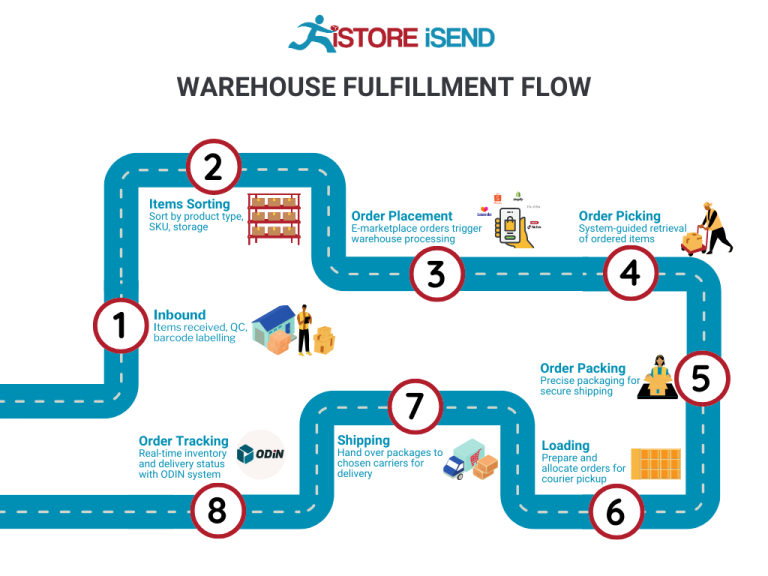
Importance: Order picking is a critical stage in the fulfillment process, as it directly impacts order accuracy and efficiency. A well-organized picking system reduces the time taken to fulfill orders and enhances customer satisfaction by ensuring timely deliveries.
Key Term: Pick Lists – These documents outline the items to be picked for each order, guiding warehouse staff to ensure accuracy and efficiency in the picking process.
4. Order Packing
After items are picked, they move to the packing stage, where they are carefully packed for shipment. This involves selecting appropriate packaging materials, ensuring items are protected during transit, and including any necessary documentation, such as invoices or return slips.
Importance: The packing process is vital for preventing damage during shipping and ensuring a positive unboxing experience for the customer. Proper packing also helps in optimizing shipping costs by minimizing the dimensions and weight of packages.
Key Term: Kitting – A process where multiple items are bundled together for shipment, often used for promotional offers or special orders, enhancing the value proposition for customers.
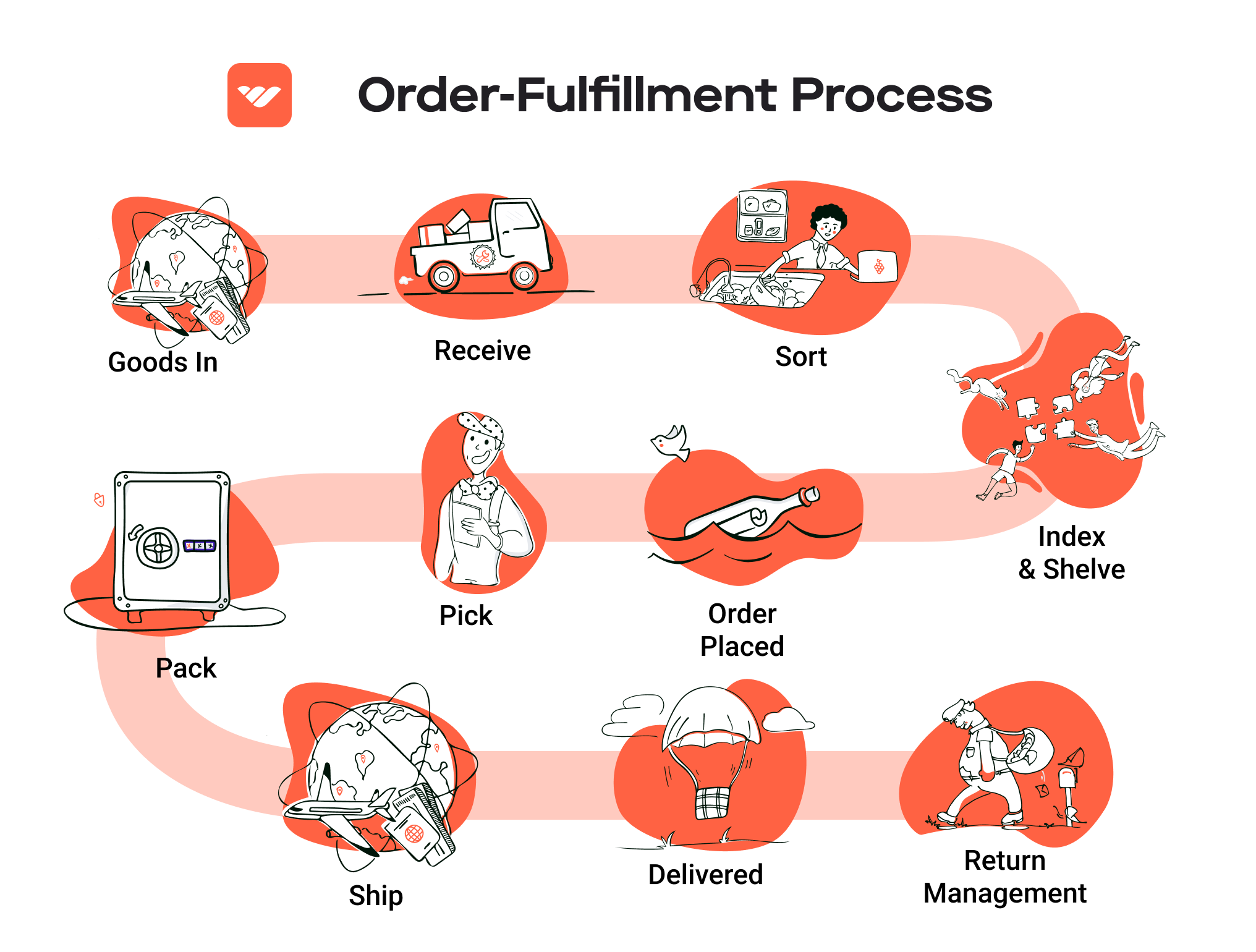
5. Shipping & Delivery
The final step in the order fulfillment process is shipping and delivery. Once orders are packed, they are labeled and handed over to shipping carriers for delivery to the customer’s address. This step includes selecting the most efficient shipping method based on factors such as speed, cost, and destination.
Importance: Timely shipping and delivery are paramount for customer satisfaction. In today’s competitive e-commerce landscape, customers expect quick and reliable delivery options. Efficient shipping processes can also lead to reduced costs and improved profitability for the business.
Key Term: Last-Mile Delivery – The final leg of the shipping process, where packages are delivered from a distribution center to the customer’s doorstep, often representing the most complex and costly part of the shipping journey.
In summary, understanding each step of the order fulfillment process is crucial for e-commerce businesses aiming to scale effectively. By optimizing these steps—receiving inventory, warehousing, order picking, packing, and shipping—businesses can enhance operational efficiency, reduce costs, and ultimately improve customer satisfaction. Implementing best practices in these areas will empower e-commerce entrepreneurs to thrive in an increasingly competitive market.
Comparing Fulfillment Models: In-House vs. 3PL vs. Dropshipping
Fulfillment Model Comparison Table
| Model | Who Handles Inventory | Best For (Business Stage) | Key Advantage | Key Disadvantage |
|---|---|---|---|---|
| In-House Fulfillment | The business itself | Established businesses | Complete control over inventory and processes | High overhead costs and resource-intensive |
| Third-Party Logistics (3PL) | 3PL provider | Growing businesses | Scalable operations and reduced management burden | Less control over inventory and fulfillment speed |
| Dropshipping | Supplier | Startups and small businesses | Low upfront investment and minimal risk | Lower profit margins and potential quality issues |
In-House Fulfillment
In-house fulfillment involves managing the entire order fulfillment process within your own business. This includes everything from inventory management, order processing, packing, and shipping. Companies that choose this model typically have established operations and sufficient resources to handle logistics themselves. The key advantage of in-house fulfillment is the complete control it affords over inventory and processes, enabling businesses to tailor operations to their specific needs and ensure a consistent customer experience. However, this control comes at a cost. The overhead can be significant, including expenses related to warehousing, staffing, equipment, and technology. Additionally, in-house fulfillment can be resource-intensive, demanding time and attention that could be better spent on core business activities like marketing and product development. This model is often best suited for businesses that have the volume and complexity to justify the investment in logistics infrastructure.
Third-Party Logistics (3PL)
Third-party logistics (3PL) providers handle various aspects of logistics, including warehousing, inventory management, order fulfillment, and shipping. This model is particularly beneficial for growing businesses that require scalable solutions without the burden of managing logistics in-house. 3PL companies offer the advantage of expertise in logistics, allowing businesses to leverage advanced technology and infrastructure without significant upfront investments. They can also provide valuable insights into shipping options and best practices, ultimately enhancing operational efficiency and customer satisfaction. However, one of the key disadvantages of 3PL is the reduced control over inventory management and fulfillment speed. Businesses must rely on their 3PL partner to execute processes effectively, which can lead to potential issues if the provider does not meet expectations. Despite this, the flexibility and scalability of 3PL make it an attractive option for businesses looking to expand their reach without the constraints of managing logistics themselves.
Dropshipping
Dropshipping is a fulfillment model where the retailer does not keep products in stock. Instead, when a customer places an order, the retailer purchases the item from a third-party supplier who then ships it directly to the customer. This model is particularly appealing for startups and small businesses, as it requires a low upfront investment and minimal risk. Retailers can offer a wide range of products without the need for significant inventory, allowing them to focus on marketing and customer acquisition. However, dropshipping comes with its own set of challenges. The most notable disadvantage is lower profit margins, as the retailer often pays a premium to the supplier for each item sold. Additionally, quality control can be a concern, as the retailer has limited oversight of the product’s condition and fulfillment process. Delays or errors in shipping can also negatively impact customer satisfaction, making it critical for businesses to choose reliable suppliers. Overall, dropshipping can be a viable entry point for entrepreneurs, but it requires careful management and strategic partnerships to ensure success.
A Deep Dive into Amazon FBA: Pros, Cons, and Who It’s For
Understanding Fulfillment by Amazon (FBA)
Fulfillment by Amazon (FBA) is a service provided by Amazon that allows e-commerce sellers to store their products in Amazon’s fulfillment centers. Once a seller enrolls in FBA, Amazon takes care of storage, packaging, shipping, and even customer service for the seller’s products. This service enables sellers to leverage Amazon’s vast logistics network and customer base, enhancing their ability to scale operations and reach more customers.
How FBA Works
-
Product Listing and Enrollment: Sellers create product listings on Amazon and select which products they want to fulfill through FBA. They then ship their inventory to one or more of Amazon’s fulfillment centers.
-
Storage: Once the products arrive at the fulfillment center, Amazon stores them until a customer places an order. This allows sellers to manage inventory without needing their own warehousing solutions.
-
Order Processing: When an order is placed, Amazon’s system automatically picks, packs, and ships the product directly to the customer. This process is designed to be efficient, ensuring that orders are fulfilled quickly.
-
Customer Service and Returns: Amazon handles all customer service inquiries related to FBA products, including processing returns. This service is a major advantage for sellers, as it alleviates the burden of managing customer interactions.
-
Payment: After the sale is completed, Amazon deducts its fees and transfers the remaining funds to the seller. This includes costs for storage, fulfillment, and any other applicable fees.
Pros of Using FBA
-
Prime Eligibility: One of the most significant advantages of FBA is that products fulfilled through Amazon are eligible for Amazon Prime. This not only increases visibility but also enhances the likelihood of sales, as Prime members often prefer products that offer free and fast shipping.
-
Customer Trust: Amazon is a trusted platform, and products fulfilled by FBA are often perceived as more reliable. Customers enjoy the assurance of Amazon’s shipping and return policies, which can lead to higher conversion rates for sellers.
-
Multi-Channel Fulfillment: FBA can be used to fulfill orders from other sales channels, such as eBay, Shopify, or a seller’s own website. This flexibility allows sellers to streamline their logistics across multiple platforms while benefiting from Amazon’s logistics infrastructure.
-
Scalability: FBA enables sellers to scale their operations without the need to invest heavily in warehousing or logistics. As sales increase, sellers can easily send more inventory to Amazon’s fulfillment centers.
-
Time Savings: By outsourcing storage, packing, shipping, and customer service to Amazon, sellers can focus on other critical aspects of their business, such as product development and marketing.
Cons of Using FBA
-
High Fees: While FBA offers numerous benefits, it comes with significant costs. Sellers are charged storage fees based on the volume of goods stored in Amazon’s fulfillment centers, as well as fulfillment fees for each order processed. These fees can add up quickly and impact profit margins, particularly for lower-priced items.
-
Strict Inventory Rules: Amazon has stringent rules regarding inventory management, including limits on the quantity of certain products that can be sent to fulfillment centers. Sellers must also adhere to specific packaging and labeling requirements, which can be cumbersome.
-
Commingling Risks: In FBA, products from different sellers may be stored together (commingling), which can lead to risks if a product is damaged or if there are issues with returns. This means that sellers may inadvertently send their customers products that were not originally theirs, complicating the return process and customer satisfaction.
-
Loss of Control: When using FBA, sellers relinquish some control over their inventory and customer interactions. Issues such as shipping delays or customer service complaints are handled by Amazon, which may not always align with the seller’s brand standards or expectations.
-
Long-Term Storage Fees: If products remain in Amazon’s warehouses for an extended period, sellers may incur long-term storage fees. This can be particularly problematic for seasonal products or items that do not sell quickly.
Who is FBA Best For?
Fulfillment by Amazon is ideal for e-commerce businesses that are looking to scale quickly and efficiently without the overhead of managing logistics in-house. It is particularly beneficial for:
-
Small to Medium-Sized Sellers: Those who may not have the resources to manage their own warehousing and logistics can significantly benefit from FBA’s comprehensive solutions.
-
Sellers with High Sales Volume: Businesses that experience high sales volume can take advantage of Amazon’s logistics capabilities, allowing them to meet customer demand effectively.
-
Brands Looking for Exposure: Sellers who want to enhance their visibility on Amazon and reach the Prime customer base will find FBA advantageous.
-
Entrepreneurs Testing New Products: FBA allows sellers to test new products with less risk, as they do not have to commit to long-term storage or logistics management.
In summary, Fulfillment by Amazon can be a powerful tool for e-commerce sellers looking to streamline their operations, enhance customer trust, and scale their business effectively. However, it is essential to weigh the pros and cons carefully, considering how FBA aligns with your business model and growth objectives.
Core Services Offered by Fulfillment Centers
Inventory Management & Warehousing
Inventory management and warehousing are foundational services provided by fulfillment centers that significantly impact an e-commerce business’s operational efficiency. This service involves receiving, storing, and managing stock levels across various products. Fulfillment centers employ advanced inventory management systems that integrate with e-commerce platforms, allowing for real-time tracking of stock levels, order statuses, and inventory turnover.
Benefits:
1. Optimized Storage: Fulfillment centers utilize sophisticated warehousing techniques, ensuring that products are stored in an organized manner, which minimizes retrieval times and maximizes space utilization.
2. Cost Efficiency: By outsourcing warehousing to a fulfillment center, businesses can reduce overhead costs associated with maintaining their own storage facilities. This includes savings on rent, utilities, and staffing.
3. Scalability: As e-commerce businesses grow, their inventory needs may fluctuate. Fulfillment centers provide the flexibility to scale storage capacity up or down without the hassle of relocating or expanding physical premises.
Pick and Pack Services
Pick and pack services are critical in the order fulfillment process. This service entails selecting the right products from the warehouse (picking) and preparing them for shipment (packing). Fulfillment centers streamline this process through efficient workflows and trained staff, often utilizing technology to enhance accuracy and speed.
Benefits:
1. Speed and Accuracy: Fulfillment centers employ systematic picking methods—such as batch picking, zone picking, or wave picking—combined with barcode scanning to ensure that the right items are picked quickly and accurately, reducing the likelihood of order errors.
2. Quality Control: A dedicated team oversees the packing process to ensure that products are securely packed, minimizing damage during transit. This not only protects the product but also enhances customer satisfaction.
3. Custom Packaging Options: Many fulfillment centers offer custom packing solutions, allowing businesses to create a unique unboxing experience for their customers. This can help strengthen brand identity and increase customer loyalty.
Kitting and Assembly
Kitting and assembly services involve grouping multiple products into a single ready-to-ship package or performing light assembly work before shipping. This is particularly beneficial for e-commerce businesses that sell products that require assembly or are often sold together as a set.
Benefits:
1. Enhanced Product Offering: By offering kitted products, businesses can create bundled deals that increase average order value. For instance, a beauty brand could offer a skincare kit that includes multiple products at a discounted price.
2. Reduced Handling Time: When products are pre-assembled or kitted, the pick and pack process is significantly streamlined, leading to faster order fulfillment times. This is particularly advantageous during peak seasons or promotional events.
3. Inventory Management: Kitting helps in managing inventory more effectively. Instead of tracking multiple SKUs, businesses can track a single kit SKU, simplifying inventory management and reducing complexity.
Returns Management (Reverse Logistics)
Returns management, or reverse logistics, is an essential service that addresses the complexities of product returns. Fulfillment centers handle the entire returns process, from receiving returned items to restocking or disposing of them as necessary. This service is crucial for maintaining customer satisfaction and loyalty in e-commerce.
Benefits:
1. Streamlined Returns Process: Fulfillment centers provide a seamless returns experience for customers, often integrating returns management systems that allow for easy tracking and processing of returns. This enhances the overall customer experience and can lead to repeat purchases.
2. Data Analysis and Insights: By analyzing return patterns, fulfillment centers can provide valuable insights into product performance, helping businesses understand which items are frequently returned and why. This data can inform future product development and inventory decisions.
3. Cost Savings: Efficient returns management minimizes costs associated with handling returns. Fulfillment centers can quickly process returns, assess the condition of returned items, and determine the best course of action—whether that’s restocking, refurbishing, or recycling.
In conclusion, leveraging the core services offered by fulfillment centers—inventory management and warehousing, pick and pack services, kitting and assembly, and returns management—can significantly enhance the operational efficiency of e-commerce businesses. These services not only save time and reduce costs but also improve customer satisfaction, ultimately contributing to sustainable growth and scalability in a competitive market.
How to Choose a Fulfillment Partner: A 6-Point Checklist
Location & Warehouse Network
Importance: The geographical location of a fulfillment partner’s warehouses significantly impacts shipping times and costs. A partner with strategically placed warehouses can facilitate faster deliveries to customers, thereby enhancing satisfaction and potentially reducing shipping expenses.
Questions to Ask:
– Where are your warehouses located, and how do they align with my target customer base?
– What is your average shipping time to major regions where my customers are located?
– Do you have the capability to open additional warehouses if my business expands?
Technology & Integrations
Importance: The technology a fulfillment partner uses can streamline operations, improve inventory management, and provide real-time data insights. Compatibility with your e-commerce platform is crucial for seamless order processing and inventory tracking.
Questions to Ask:
– What order management system (OMS) do you use, and how does it integrate with platforms like Shopify, WooCommerce, or Amazon?
– Can you provide real-time inventory tracking, and how is this information shared with your clients?
– What automation tools do you have in place to minimize human error and improve efficiency?
Specializations (e.g., cold storage, oversized items)
Importance: Depending on the nature of your products, you may require a fulfillment partner with specific capabilities, such as cold storage for perishable goods or handling oversized items. Choosing a partner with the right specialization ensures that your products are stored and handled appropriately.
Questions to Ask:
– What specific product types do you specialize in, and do you have facilities to accommodate my inventory needs?
– Can you handle special requirements, such as temperature control or fragile items?
– What protocols do you have in place for managing unique inventory challenges?
Scalability & Capacity
Importance: As your business grows, so will your fulfillment needs. A suitable partner should not only meet your current demands but also have the capacity and flexibility to scale operations as you expand into new markets or launch new products.
Questions to Ask:
– How do you handle seasonal fluctuations in order volume?
– What is your current capacity, and how can it be adjusted as my business grows?
– Are there any limitations on the types of products you can handle as my business scales?
Pricing and Contracts
Importance: Understanding the pricing structure and contract terms of a fulfillment partner is essential for budgeting and financial planning. Transparency in costs helps avoid unexpected fees that can impact your bottom line.
Questions to Ask:
– Can you provide a detailed breakdown of your pricing model, including storage fees, pick and pack fees, and shipping costs?
– Are there any additional costs I should be aware of, such as for returns processing or special handling?
– What are the terms for contract length and cancellation, and are there any penalties for early termination?
Customer Support & Reviews
Importance: Strong customer support is vital for resolving issues quickly and maintaining operational efficiency. Additionally, researching a partner’s reputation through reviews can provide insights into their reliability and service quality.
Questions to Ask:
– What kind of customer support do you offer, and how can I reach your team in case of issues?
– Can you provide references or case studies from businesses similar to mine?
– How do you handle customer complaints or fulfillment errors, and what is your resolution process?
By thoroughly evaluating potential fulfillment partners against this checklist, e-commerce business owners can make informed decisions that align with their operational needs and growth aspirations. Remember that the right partner is not just a service provider but a crucial ally in your journey to scale your business efficiently.
Understanding Fulfillment Pricing: A Breakdown of Common Fees
Initial Setup Fees
When partnering with a third-party logistics (3PL) provider, businesses often encounter initial setup fees. These costs are associated with the onboarding process, which includes integrating your e-commerce platform with the 3PL’s system, configuring inventory management software, and establishing logistics workflows.
Setup fees can vary significantly based on the complexity of your operations and the technology required. For instance, if your business has multiple product lines or requires custom software integrations, the setup fees may be higher. Typically, these fees can range from a few hundred to several thousand dollars. To minimize these costs, it’s advisable to clearly outline your business requirements during the initial discussions and seek providers that offer flexible setup options.
Receiving Fees
Receiving fees are charged by fulfillment centers for the process of accepting and inspecting your inventory upon arrival at their warehouse. This includes unloading shipments, checking for damages, and entering the products into the inventory management system.
These fees are generally calculated on a per-pallet or per-box basis, with prices depending on the volume and complexity of the received goods. For example, if your shipments are large and require more handling time, the receiving fees may increase. It’s essential to ask your 3PL provider for detailed information on their receiving processes and any associated costs to avoid unexpected charges.
Storage Fees (per pallet/bin)
Storage fees are incurred for keeping your products in the fulfillment center’s warehouse. These fees are usually calculated on a per-pallet or per-bin basis, depending on how your inventory is organized.
The rate can vary based on factors such as the geographic location of the warehouse, the type of products being stored (e.g., bulky or fragile items), and the length of time the items remain in storage. Some 3PLs may also charge a premium for peak seasons when storage space is in higher demand. Understanding the storage fee structure is crucial for managing your inventory costs effectively. To optimize storage expenses, consider implementing just-in-time inventory strategies that align with your sales forecasts.
Pick & Pack Fees (per item/order)
Pick and pack fees are charged for the labor involved in retrieving items from storage and preparing them for shipment. This fee structure can be based on the number of items picked per order or a flat rate per order.
If your business has a high volume of small orders, this fee can quickly add up. Additionally, costs may increase for special packing requirements, such as gift wrapping or custom packaging. To better manage these fees, establish clear packing guidelines with your 3PL provider and explore options for bulk orders or consolidated shipments that can reduce overall picking costs.
Shipping Fees
Shipping fees are among the most significant costs associated with fulfillment services. These fees cover the transportation of your products to customers and can vary based on several factors, including the weight and dimensions of the package, the shipping method (standard, expedited, international), and the destination.
Most 3PLs negotiate shipping rates with carriers, which can lead to cost savings for your business. It’s important to inquire about the shipping options available and how rates are calculated. Additionally, consider using a fulfillment partner that offers transparent pricing and access to multiple shipping carriers to ensure you’re getting the best rates possible.
Tips for Getting an Accurate Quote
-
Provide Detailed Information: When requesting quotes, supply potential 3PL providers with comprehensive details about your inventory, order volume, and specific logistics needs. This will help them tailor their pricing to your business model.
-
Ask About Hidden Fees: Inquire about any additional fees that may not be immediately apparent, such as for returns processing or seasonal storage increases. Understanding the full cost structure will help you avoid surprises later.
-
Evaluate Multiple Providers: Don’t settle for the first quote you receive. Compare offers from several fulfillment companies to gauge a competitive price and service level.
-
Review Contracts Carefully: Before signing any agreements, thoroughly review the contract terms, especially concerning fees and services. Ensure clarity on how fees are structured and any conditions that may lead to increased costs.
By understanding these common fulfillment pricing models and following these tips, you can make more informed decisions and select the right 3PL partner for your e-commerce business. This proactive approach will not only help control costs but also enhance overall operational efficiency.
Frequently Asked Questions (FAQs) about Fulfillment
1. What is a 3PL (Third-Party Logistics) provider?
A 3PL provider is a company that offers a range of logistics services, including warehousing, transportation, order fulfillment, and inventory management. By outsourcing these functions to a 3PL, e-commerce businesses can focus on core activities like product development and marketing while benefiting from the provider’s expertise in supply chain management.
2. How does a fulfillment center operate?
A fulfillment center operates by receiving inventory, storing it until orders are placed, and then picking, packing, and shipping those orders to customers. This process is designed for efficiency, ensuring that orders are processed quickly to enhance customer satisfaction and reduce shipping times.
3. What’s the difference between a warehouse and a fulfillment center?
While both warehouses and fulfillment centers store goods, their functions differ significantly. A warehouse primarily focuses on long-term storage and inventory management. In contrast, a fulfillment center is an active hub where goods are regularly received, picked, packed, and shipped in response to customer orders, making it more dynamic and service-oriented.
4. How much do fulfillment services cost?
The cost of fulfillment services varies based on factors such as order volume, storage needs, shipping destinations, and the specific services required (e.g., kitting, returns management). Typically, businesses can expect to pay for storage space, order processing fees, and shipping costs. It’s advisable to request a detailed pricing quote from potential 3PL partners to understand the total costs involved.
5. What are the benefits of using a 3PL fulfillment company?
Using a 3PL fulfillment company can provide numerous benefits, including reduced operational costs, access to advanced technology, improved shipping speeds, and scalability. These providers also manage complex logistics processes, allowing businesses to enhance customer satisfaction without the burden of handling logistics in-house.
6. How do I choose the right 3PL provider for my business?
Selecting the right 3PL provider involves assessing your business needs, evaluating potential partners’ capabilities, and considering factors such as technology integration, customer service, scalability, and pricing. It’s important to conduct thorough research and potentially request references or case studies to ensure the provider aligns with your operational goals.
7. What is outsourced fulfillment?
Outsourced fulfillment refers to the practice of hiring external companies (3PLs) to manage various aspects of the order fulfillment process, including inventory management, order processing, packing, and shipping. This approach allows businesses to streamline operations and focus on growth without the complexities of logistics management.
8. Can a 3PL provider help with international shipping?
Yes, many 3PL providers offer international shipping solutions, including customs clearance and freight forwarding services. They can help navigate the complexities of cross-border logistics, ensuring compliance with regulations and efficient delivery to international customers.
9. What technology do 3PL providers use to manage fulfillment?
3PL providers often utilize advanced technology such as warehouse management systems (WMS), inventory management software, and order processing platforms. These technologies enhance efficiency, provide real-time inventory tracking, and facilitate seamless integration with e-commerce platforms to streamline operations.
10. How do returns work with a 3PL fulfillment company?
Returns management with a 3PL provider typically involves a streamlined process where customers can easily return products. The 3PL handles the logistics of returns, including processing returned items, restocking inventory, and updating inventory counts. This allows businesses to maintain customer satisfaction and manage returns efficiently without adding strain to their operations.
Conclusion: Is Outsourcing Fulfillment the Right Move for Your Business?
Evaluating the Benefits of Outsourcing Fulfillment
Outsourcing fulfillment can be a transformative decision for e-commerce businesses aiming to scale efficiently. One of the most significant advantages is time savings. By entrusting inventory management, order processing, and shipping to a third-party logistics (3PL) provider, you can redirect your focus to core business functions such as product development and marketing. This shift not only enhances productivity but also allows for quicker responses to market changes.
Scalability is another critical benefit. As your business grows, so do the complexities of managing logistics. A reliable fulfillment partner can seamlessly adjust to your changing needs, whether that means increasing storage capacity or adapting to seasonal fluctuations in order volume. This flexibility is essential for maintaining service quality and customer satisfaction during peak times.
Moreover, 3PLs bring expertise and technology to the table that many small and medium-sized businesses may struggle to develop in-house. From advanced inventory tracking systems to optimized shipping solutions, these providers offer the tools and knowledge necessary to streamline operations and enhance performance.
However, the choice of fulfillment partner is paramount. Not all 3PLs are created equal, and selecting the right one can significantly impact your growth trajectory. Consider factors such as industry experience, technology integration, and customer service capabilities when evaluating potential partners.
Call to Action
Take a moment to audit your current shipping and fulfillment processes. Are they aligned with your growth objectives? If inefficiencies exist, it may be time to explore outsourcing fulfillment. By partnering with a 3PL, you can unlock the potential for increased efficiency, better customer experiences, and ultimately, business growth. Don’t hesitate to take that next step—your future success may depend on it.
Important Disclaimer
⚠️ Important Disclaimer
The information in this guide is for educational purposes. Fulfillment services, pricing, and platform features change frequently. Always conduct your own due diligence and consult with providers directly before making business decisions.
